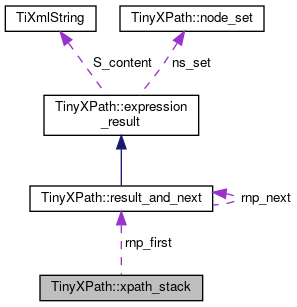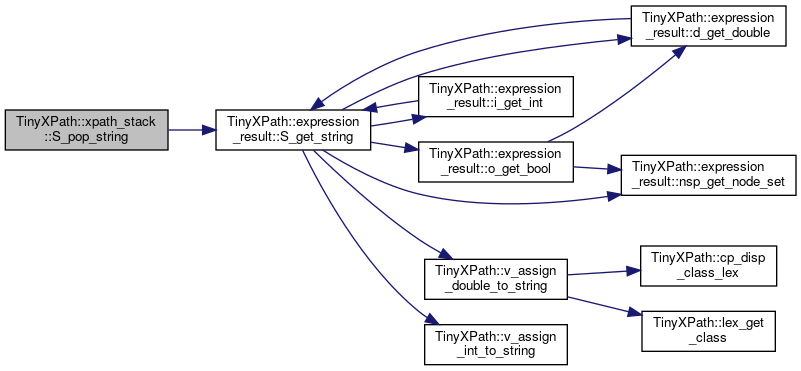#include <xpath_stack.h>

Public Member Functions | |
| xpath_stack () | |
| Constructor. More... | |
| ~ xpath_stack () | |
| void | v_push (expression_result er_res) |
| Push a new element on the stack. More... | |
| void | v_push_int (int i_elem, const char *cp_comment=NULL) |
| Push an integer on the stack. More... | |
| void | v_push_bool (bool o_in) |
| Push a bool on the stack. More... | |
| void | v_push_string (TiXmlString S_in) |
| Push a string on the stack. More... | |
| void | v_push_double (double d_elem) |
| Push a double on the stack. More... | |
| void | v_push_node_set (node_set *nsp_ptr) |
| Push a node_set on the stack. More... | |
| expression_result * | erp_top () |
| Retrieve top expression from the stack. More... | |
| int | i_top_int () |
| Query the top integer. More... | |
| void | v_pop (unsigned u_nb=1) |
| Pop N element from the stack. More... | |
| int | i_pop_int () |
| Pops the top integer from the stack. More... | |
| TiXmlString | S_pop_string () |
| Pops the top string from the stack. More... | |
| bool | o_pop_bool () |
| Pops the top bool from the stack. More... | |
| node_set | ns_pop_node_set () |
| Pops the top node_set from the stack. More... | |
| unsigned | u_get_size () |
| Return the stack's size. More... | |
| expression_result * | erp_previous (unsigned u_nb) |
| Retrieve a previous expression from the stack. More... | |
Protected Member Functions | |
| void | v_pop_one () |
| Pop one element from the stack. More... | |
Protected Attributes | |
| result_and_next * | rnp_first |
| First element in the stack. More... | |
| unsigned | u_size |
| Stack size. More... | |
Detailed Description
The XPath execution stack
All elements are result_and_next elements
Constructor & Destructor Documentation
◆ xpath_stack()
| TinyXPath::xpath_stack::xpath_stack | ( | ) |
◆ ~ xpath_stack()
| TinyXPath::xpath_stack::~ xpath_stack | ( | ) |
Member Function Documentation
◆ v_push()
| void TinyXPath::xpath_stack::v_push | ( | expression_result | er_res | ) |
Push a new element on the stack.
References TinyXPath::result_and_next::result_and_next().

◆ v_push_int()
| void TinyXPath::xpath_stack::v_push_int | ( | int | i_elem, |
| const char * | cp_comment = NULL |
||
| ) |
Push an integer on the stack.
References TinyXPath::expression_result::v_set_comment(), and TinyXPath::expression_result::v_set_int().

◆ v_push_bool()
| void TinyXPath::xpath_stack::v_push_bool | ( | bool | o_in | ) |
Push a bool on the stack.
References TinyXPath::expression_result::v_set_bool().

◆ v_push_string()
| void TinyXPath::xpath_stack::v_push_string | ( | TiXmlString | S_in | ) |
Push a string on the stack.
References TinyXPath::expression_result::v_set_string().

◆ v_push_double()
| void TinyXPath::xpath_stack::v_push_double | ( | double | d_elem | ) |
Push a double on the stack.
References TinyXPath::expression_result::v_set_double().

◆ v_push_node_set()
| void TinyXPath::xpath_stack::v_push_node_set | ( | node_set * | nsp_ptr | ) |
Push a node_set on the stack.
References TinyXPath::expression_result::v_set_node_set().

◆ erp_top()
| expression_result * TinyXPath::xpath_stack::erp_top | ( | ) |
Retrieve top expression from the stack.
◆ i_top_int()
| int TinyXPath::xpath_stack::i_top_int | ( | ) |
Query the top integer.
References TinyXPath::expression_result::i_get_int().

◆ v_pop()
| void TinyXPath::xpath_stack::v_pop | ( | unsigned | u_nb = 1 | ) |
Pop N element from the stack.
References TinyXPath::result_and_next::rnp_get_next().

◆ i_pop_int()
| int TinyXPath::xpath_stack::i_pop_int | ( | ) |
Pops the top integer from the stack.
References TinyXPath::expression_result::i_get_int().

◆ S_pop_string()
| TiXmlString TinyXPath::xpath_stack::S_pop_string | ( | ) |
Pops the top string from the stack.
References TinyXPath::expression_result::S_get_string(), and TIXML_STRING.

◆ o_pop_bool()
| bool TinyXPath::xpath_stack::o_pop_bool | ( | ) |
Pops the top bool from the stack.
References TinyXPath::expression_result::o_get_bool().

◆ ns_pop_node_set()
| node_set TinyXPath::xpath_stack::ns_pop_node_set | ( | ) |
Pops the top node_set from the stack.
References TinyXPath::expression_result::nsp_get_node_set().

◆ u_get_size()
|
inline |
Return the stack's size.
References erp_previous(), and u_size.

◆ erp_previous()
| expression_result * TinyXPath::xpath_stack::erp_previous | ( | unsigned | u_nb | ) |
Retrieve a previous expression from the stack.
- Parameters
-
u_nb Nb of items to skip.
References TinyXPath::result_and_next::rnp_get_next().
Referenced by u_get_size().


◆ v_pop_one()
|
protected |
Pop one element from the stack.
References TinyXPath::result_and_next::rnp_get_next().

Member Data Documentation
◆ rnp_first
|
protected |
First element in the stack.
◆ u_size
|
protected |
Stack size.
Referenced by u_get_size().
The documentation for this class was generated from the following files:


 1.8.13
1.8.13